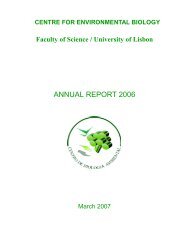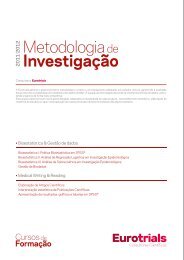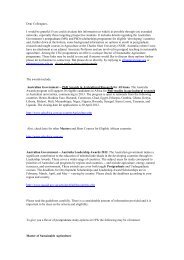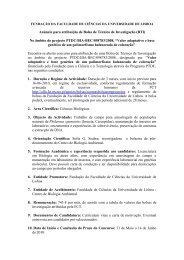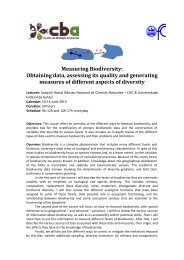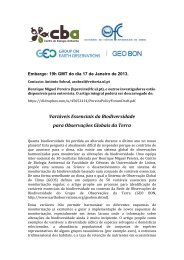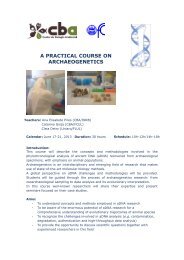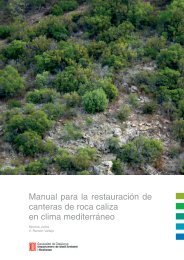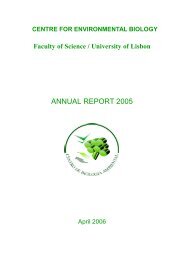European Red List of Vascular Plants - European Commission
European Red List of Vascular Plants - European Commission
European Red List of Vascular Plants - European Commission
Create successful ePaper yourself
Turn your PDF publications into a flip-book with our unique Google optimized e-Paper software.
indica aggressively compete for space, light and other<br />
resources with native species in a way that <strong>of</strong>ten leads to<br />
the disappearance <strong>of</strong> the latter. Grazing and trampling by<br />
introduced or native herbivores (such as rabbits, goats or<br />
sheep) impact several plants. But also increased seagull<br />
populations can cause problems with eutrophication<br />
for example for the Portuguese island endemic Armeria<br />
berlengensis.<br />
Many plant species are very attractive and therefore<br />
collected for their beauty. This collection ranges from<br />
the occasional picking to systematic collection for the<br />
horticultural trade (e.g. snowdrops - Galanthus spp.,<br />
orchids), medicinal use (e.g. Artemisia granatensis or<br />
Mandragora <strong>of</strong>ficinarum), or for food (Thymus spp.,<br />
Micromeria taygetea). Here the threat is not only the<br />
removal <strong>of</strong> the species from the wild but there are<br />
indirect implications such as a reduced reproductive<br />
success due to overcollection. It needs to be said that for<br />
many species under legislation the collection is already<br />
forbidden, restricted, or regulated although this does not<br />
exclude illegal activities.<br />
A major driver <strong>of</strong> habitat loss is urban and tourism<br />
development as well as transport infrastructure which<br />
affects most <strong>of</strong> the policy plant species assessed. It is not<br />
only the fact that the plants can not cope with a change<br />
<strong>of</strong> its habitat due to an increased use by humans. But the<br />
expansion <strong>of</strong> urban environments or the development <strong>of</strong><br />
new tourist complexes or roads is creating impermeable,<br />
sealed surfaces and a loss <strong>of</strong> soil habitat for the species.<br />
Mining and quarrying is another driver <strong>of</strong> habitat loss<br />
and degradation.<br />
Many species listed in this group are found in rocky areas,<br />
on cliffs, in scree or instable substrate and are vulnerable<br />
to geological events such as landslides and avalanches.<br />
Although this is not a human induced threat, it can<br />
seriously affect a population especially if the species is rare<br />
and found at very few localities or with a low number<br />
<strong>of</strong> individuals in the first place. Fires, which can occur<br />
naturally or be set by humans can have devastating effects<br />
on plant populations. An example is the fire that took<br />
place in the Central Mountain Massif <strong>of</strong> Madeira in<br />
summer 2010 where it is still not clear how it affected<br />
several endemic plant species such as Viola paradoxa or<br />
Sorbus maderensis.<br />
to other plants or change the native species dynamic<br />
and increase competition. Especially plants bound to<br />
freshwater environments are affected by water pollution.<br />
The effects <strong>of</strong> climate change on the selected plant species<br />
namely establishes itself in the form <strong>of</strong> increased droughts,<br />
particularly in the Mediterranean area. Other impacts are<br />
an increase in storms and floods, habitat shifting and<br />
alteration, and temperature extremes (Arnell 2004).<br />
For several species human disturbance in form <strong>of</strong> work<br />
activities such as cleaning <strong>of</strong> beaches (Kosteletzkya<br />
pentacarpa), mowing activities at inappropriate times<br />
(Biscutella neustriaca), removal <strong>of</strong> forest undergrowth or<br />
roadside vegetation (Erodium rupicola), etc. is causing<br />
population declines.<br />
Last but not least, it should be noted that most plants are<br />
faced by more than one threat and that a combination <strong>of</strong><br />
these can worsen the situation for a species even more,<br />
for example, increased drought also increases the risk <strong>of</strong><br />
fires.<br />
3.5 Population trends<br />
For the selected policy plant species, 38.4% have a<br />
declining population trend, whereas 21.8% <strong>of</strong> the plants<br />
have stable populations. More than one third (36.7%)<br />
have an unknown trend and a small part <strong>of</strong> the group<br />
(3.1%) have increasing populations (Figure 9).<br />
Figure 9. Population trends <strong>of</strong> <strong>European</strong> policy plants<br />
Pollution comes in the form <strong>of</strong> water pollution and <strong>of</strong><br />
garbage disposal. Water pollution is mainly caused by<br />
run-<strong>of</strong>f from agricultural fields and the application <strong>of</strong><br />
fertilisers, pesticides and herbicides which can be harmful<br />
16



